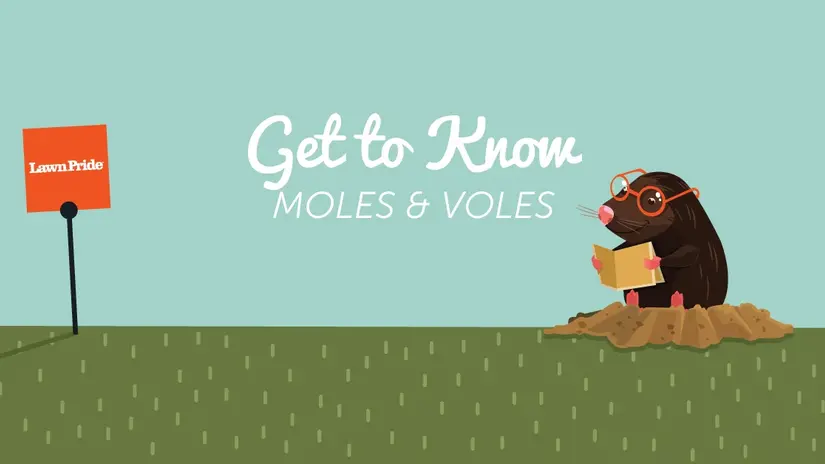
Early Season Alert: Increased Mole and Vole Activity
Homeowners will likely experience a surge in mole and vole activity this spring, with reports of damage occurring earlier and more extensively this year. These subterranean pests can transform meticulously maintained lawns into unsightly landscapes characterized by tunnel ridges, mounds, and damaged plant material.
While often confused with one another, moles and voles represent distinct species with different biological characteristics, dietary preferences, and behavioral patterns. Understanding these differences is essential for implementing effective control strategies tailored to your specific infestation.
The Differences Between Moles and Voles
How Big Are Moles and Voles?
Understanding how big moles and voles are can help in identification:
- Moles: Typically 4-7 inches in length, with large front feet adapted for digging
- Voles: Usually 3-5 inches long, with smaller ears and a short tail
What Does a Mole Look Like?
Moles have velvety fur, small or nearly invisible eyes, and no external ears. Their most distinguishing feature is their large, paddle-like front feet, which they use to burrow underground.
What Does a Vole Look Like?
Voles resemble mice but have shorter tails, rounder heads, and smaller ears. They are often mistaken for field mice but tend to be stockier.
Other Mole Characteristics
- Biology: Insectivores (not rodents) with cylindrical bodies, vestigial eyes, and distinctive large, paddle-shaped front feet
- Diet: Primarily consume earthworms, grubs, and soil-dwelling insects
- Habitat: Create deep tunneling systems with raised ridges and conical mounds of soil (molehills)
- Damage Pattern: Tunneling disrupts root systems and creates unstable surface conditions
Other Vole Characteristics
- Biology: Small rodents resembling mice but with shorter tails, rounder heads, and smaller ears
- Diet: Herbivores that feed on grass roots, bulbs, tubers, and bark
- Habitat: Create surface runways approximately 1-2 inches wide with multiple entrance holes
- Damage Pattern: Gnaw on roots and bark, causing plant decline and death, particularly to ornamental shrubs and trees
Identifying Vole vs Mole Damage in Your Property
Mole Evidence
- Raised, volcano-shaped soil mounds (typically 2-8 inches high)
- Elevated tunnel ridges that feel spongy underfoot
- Damage appearing in patterns that follow food sources rather than property lines
- Most active in spring and fall when soil moisture is optimal
Vole Evidence
- Surface runways visible in lawn areas, often connecting to small, clean-cut holes
- Gnawing damage at the base of young trees and shrubs
- Population increases notable during mild winters with consistent snow cover
- Activity concentrated near landscape beds and areas with protective ground cover
How Lawn Pride Gets Rid of Voles and Moles Permanently
Lawn Pride of Indianapolis Mole Control
Professional mole management focuses on disrupting both the tunneling activity and reducing access to food sources. Treatment protocols include:
- Targeted application of specialized repellents in active tunnel systems
- Reduction of soil-dwelling insect populations to minimize food availability
- Ongoing monitoring to identify and address new tunneling activity promptly
- Preventative perimeter treatments during peak activity seasons
Lawn Pride of Indianapolis Vole Control
Effective vole control requires a multi-faceted approach to habitat modification and population management:
- Reduction of protective cover through vegetation management
- Strategic placement of deterrents near vulnerable plantings
- Adjustment of mulch depth in landscape beds (maintaining less than 2 inches)
- Protection of tree trunks and shrub bases from gnawing damage
Why Early Intervention Matters
The life cycles of both moles and voles can lead to rapid population increases when left unmanaged. A single female vole can produce up to 30 offspring annually, while moles can excavate up to 100 feet of new tunnels daily during peak activity periods.
Indiana's clay-heavy soils are particularly vulnerable to structural damage from mole tunneling, as water infiltration through these channels can lead to significant erosion and foundation concerns over time.
Environmental Considerations
While controlling these pests is necessary to protect your property, it's important to implement methods that minimize impact on beneficial wildlife and the broader ecosystem. Our integrated management approach prioritizes targeted interventions over broad-spectrum treatments to maintain ecological balance.
Contact Lawn Pride for an Assessment and Treatment in Central Indiana
If you've observed signs of mole or vole activity on your Indianapolis property, professional evaluation is recommended to:
- Correctly identify the specific pest species present
- Determine the extent and pattern of the infestation
- Develop a customized treatment protocol
- Implement preventative measures to reduce future vulnerability
Our certified technicians are experienced in identifying and managing both mole and vole populations throughout Central Indiana's diverse landscape environments.
Contact our team today for a property assessment and comprehensive control strategy tailored to your specific lawn protection needs.
